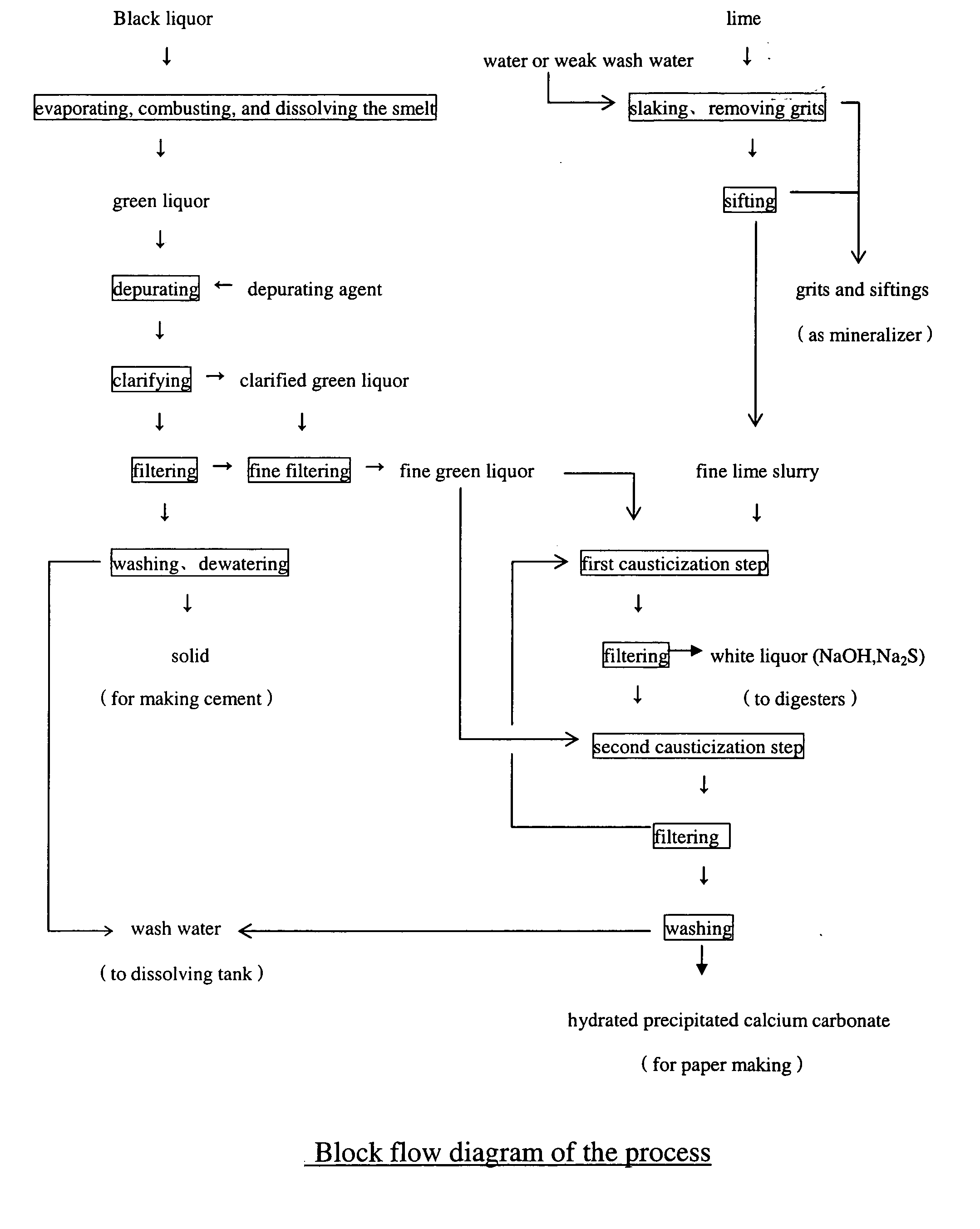Process of recovering alkali from black liquor of papermaking
a technology of black liquor and process, applied in the field of improvement, can solve the problems of affecting the purity of caco, unable to use lime mud as a valuable commercial, etc., and achieve the effects of reducing the energy consumption of the chemical recovery process, reducing equipment investment and good quality
- Summary
- Abstract
- Description
- Claims
- Application Information
AI Technical Summary
Benefits of technology
Problems solved by technology
Method used
Image
Examples
example 2
[0032] 200 weight parts of lime was slaked with water to form lime slurry. The rough lime grits was removed from the lime slurry, and then the lime slurry was sifted with a 500 mesh sieve screen. The sifted fine lime slurry was ready to use for causticization. The rough lime grits and the siftings were combined and incorporated into coal power as a mineralizing agent when the coal was burned in a coal burning boiler.
[0033] The first causticization step was conducted by adding the fine green liquor obtained in the Example 1 and the fine lime slurry obtained in the present example into a causticiser, at a reaction temparature of 38° C. and a total alkalinity of causticization liquor of 102 g / L (expressed as NaOH), wherein the quantity of CaO in the fine lime slurry was 1.5 times of the theoretical quantity needed for the causticization reaction. After the first causticization step, the liquid and solid phases were separated by filtration. The filtered liquid was called white liquor (...
example 3
[0034] In this example, the green liquor was obtained from the combustion procedure of the chemical recovery process in a soda method bagasse pulp mill, and was depurated according to Example 1. When lime was depurated, the lime slurry was sifted with a 600 mesh sieve screen. The two causticization steps was conducted at a reaction temparature of 30° C. and a total alkalinity of causticization liquor of 106 g / L (expressed as NaOH). The test results of the obtained calcium carbonate are shown in Table 1.
example 4
[0035] A quantity of green liquor containing 318 weight parts of Na2CO3 was obtained from the combustion procedure of the chemical recovery process in a Kraft method reed pulp mill, added in a depurator, and heated to 66° C. A depurating agent solution containing 2.8 weight parts of CaCl2 was added into the depurator under stirring. After sufficient agitation, the mixed green liquor was transferred into a clarifier. The supernatant of the clarified green liquor was fine filtered. The fine filtered fine green liquor was ready to use for causticization. The dregs slurry from the bottom of the clarifier was subjected to filtration. The filtered green liquor from the dregs slurry was combined with the clarified green liquor. The filtered solids together with the fine filtered solid were combined, washed and dehydrated, and then were used as a primary material for cement production. When lime was depurated, the lime slurry was sifted with a 400 mesh sieve screen. The two causticization s...
PUM
| Property | Measurement | Unit |
|---|---|---|
| temperature | aaaaa | aaaaa |
| temperature | aaaaa | aaaaa |
| particle size | aaaaa | aaaaa |
Abstract
Description
Claims
Application Information
 Login to View More
Login to View More - R&D
- Intellectual Property
- Life Sciences
- Materials
- Tech Scout
- Unparalleled Data Quality
- Higher Quality Content
- 60% Fewer Hallucinations
Browse by: Latest US Patents, China's latest patents, Technical Efficacy Thesaurus, Application Domain, Technology Topic, Popular Technical Reports.
© 2025 PatSnap. All rights reserved.Legal|Privacy policy|Modern Slavery Act Transparency Statement|Sitemap|About US| Contact US: help@patsnap.com


